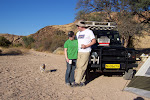This article is from the website Real Namibia and I thought it might give everyone an opportunity to learn a little about Christmas in Namibia. Enjoy
When asked what he or she wants for Christmas, the average Namibian will give the automatic response ‘rain’. This answer does not just mean rain during the coming year. It also specifically hopes for rain on Christmas Day.
It is rare that Santa delivers on this request, and if it does rain it will quite likely be in a place where you are not. I asked a local weatherman what the prospects were for rain on Christmas Day this year, and he laughed at me. He said there is a very slender chance, but only for those people living in the far north-eastern Caprivi. Lucky them!
The period from about a month before to a month after Christmas is usually bone dry and very, very hot. Tempers tend to get ragged as the oppressive temperature rises and people begin to dry out. Fortunately the prospect of Christmas keeps everyone in a fairly good mood.
As in most countries that celebrate Christmas, the shop decorations begin to come out in October, just in case you forget to do your Christmas shopping. The decorative town lights, in larger centers, follow shortly afterwards.
Sometime in early December, the taxis begin to make a show of Christmas, with tinsel on their dashboards and baubles hanging from their mirrors. More festive, heat-resistant souls don Father Christmas hats in spite of the heat, as do many people working in retail.
Office Christmas parties usually take place in late November and last into the first week of December. This is due to the certain knowledge that those who can will take their summer holiday. In the second week of December, bonuses and 13th cheques begin to arrive, bringing with them the spirit and bottles of Christmas.
The most conspicuously Namibian aspect to Christmas is the mass migration from Windhoek. This alters the shape of towns and families across the country and messes up Santa Claus’s delivery schedule no end.
Roadblocks appear on all major roads. These are put in place to monitor the safety of vehicles, check vehicle worthiness, check drivers’ licences, fine and turn back overloaded vehicles and, at the coast, to check for excessive catches and illegal crayfish catches. None of the roadblocks has ever delayed Santa.
Those who have family ties to communal farms will if possible go back to the communal areas. Migrant workers will take gifts with them and the firm intent to do whatever repairs and improvements are necessary. Long distance taxis do very good business.
Everyone else who can afford to do so or who is not manning an office or shop will head off for the coast, to ‘get away from it all’. Once at the coast, they will complain that they might as well have stayed where they were because everyone they know is at the coast. On the other hand, the coast has the advantage of cool, misty mornings and evenings.
The people who live at the coast complain about all the people coming to Swakopmund, and how the prices always go up tremendously about a week before the holidaymakers arrive. Shopkeepers however stay silent and allow their very broad grins to speak for them.
Namibia celebrates two Christmases. Many of the Namibian Germans celebrate their Christmas and give gifts on Christmas Eve. For the rest of Namibia, the celebration is on Christmas Day. Churches follow the pattern of services on Christmas Eve and Christmas morning.
If anything else is common to the Namibian Christmas, it is the fact that Christmas is a time of red meat. Although turkey has made its appearance in some households, it is not a major phenomenon. In rural communities it is not unusual to slaughter a goat. Beef is fairly common, though this will usually be purchased from a butcher, rather than slaughtering a valuable head of cattle. The traditional accompaniment for the vast majority of Namibians is ‘pap’, a stiff maize porridge or porridge made from Mahangu, Namibia’s version of millet.
The typical commercial Christmas tree is evident in many Namibian homes, however, as a point of interest, many people opt for branches of the Camelthorn tree which are entirely more suited to the spirit of a Namibian Christmas. The normally wicked, long white thorns make excellent hooks for decorations, and the feeling is that the tree ‘belongs’ rather than being an import.
Namibia is a country of many cultures, so there is no ‘one’, socially acceptable form of Christmas. That being said, the common strands are family, even if it involves long distance travel, a desire for rain and meat.
Like every country, Christmas in Namibia is a time of good cheer. If you are from abroad, have a very happy Christmas and a prosperous New Year. If you are a local, I also hope it rains.
Friday, December 21, 2007
Wednesday, December 5, 2007
How to Support Us
There are a number of ways to support our mission work in Namibia.
1.) Prayer-Please put Penny and I on your parish prayer list and keep us in your prayers.
2.) Invitations to speak at Christian Ed events or dinners on topics of mission, and the Millenium Development Goals
3.) Pledges of support-Please make a financial committment to our work. Each year we are asked to raise $26,000 to support our mission. Donations of $25, $50, $100 or $200 a month add up quickly. Checks can be sent through the Diocese of Alabama with a memo for Mission Namibia. Please consider asking your parish to support us through their outreach budget.
4.) Tell your friends about us and tell them about Namibia.
1.) Prayer-Please put Penny and I on your parish prayer list and keep us in your prayers.
2.) Invitations to speak at Christian Ed events or dinners on topics of mission, and the Millenium Development Goals
3.) Pledges of support-Please make a financial committment to our work. Each year we are asked to raise $26,000 to support our mission. Donations of $25, $50, $100 or $200 a month add up quickly. Checks can be sent through the Diocese of Alabama with a memo for Mission Namibia. Please consider asking your parish to support us through their outreach budget.
4.) Tell your friends about us and tell them about Namibia.
Why we are going to Namibia
These photos were forwarded to me last week from my friend The Rev. Lukas Katenda. They were sent to him from Nancy Robson at St. Mary's in Odibo. They were accompanied by an email thanking the young m an who donated all the Beanie Babies and noting that only 5 or 6 of the children in these photos had ever had a toy of their own. These are the children of the Joy to the World Kindergarden in Onekweya. When we visited in last June we met many of these children and their teacher Sr. Gertrude. At that time she was the only teacher for 56 students. They had no books, and no toys but Sister Gertrude (pictured above) was doing her best to teach the children. They sang us songs and spoke to us in english. Many of these children are AIDS orphans from the nearby area. The latest estimate is that by next year when we move to Namibia there will be 100,000 orphans in the country. With a population of only 1.8 million that means that close to 6% of the population will be orphans.
an who donated all the Beanie Babies and noting that only 5 or 6 of the children in these photos had ever had a toy of their own. These are the children of the Joy to the World Kindergarden in Onekweya. When we visited in last June we met many of these children and their teacher Sr. Gertrude. At that time she was the only teacher for 56 students. They had no books, and no toys but Sister Gertrude (pictured above) was doing her best to teach the children. They sang us songs and spoke to us in english. Many of these children are AIDS orphans from the nearby area. The latest estimate is that by next year when we move to Namibia there will be 100,000 orphans in the country. With a population of only 1.8 million that means that close to 6% of the population will be orphans.
 an who donated all the Beanie Babies and noting that only 5 or 6 of the children in these photos had ever had a toy of their own. These are the children of the Joy to the World Kindergarden in Onekweya. When we visited in last June we met many of these children and their teacher Sr. Gertrude. At that time she was the only teacher for 56 students. They had no books, and no toys but Sister Gertrude (pictured above) was doing her best to teach the children. They sang us songs and spoke to us in english. Many of these children are AIDS orphans from the nearby area. The latest estimate is that by next year when we move to Namibia there will be 100,000 orphans in the country. With a population of only 1.8 million that means that close to 6% of the population will be orphans.
an who donated all the Beanie Babies and noting that only 5 or 6 of the children in these photos had ever had a toy of their own. These are the children of the Joy to the World Kindergarden in Onekweya. When we visited in last June we met many of these children and their teacher Sr. Gertrude. At that time she was the only teacher for 56 students. They had no books, and no toys but Sister Gertrude (pictured above) was doing her best to teach the children. They sang us songs and spoke to us in english. Many of these children are AIDS orphans from the nearby area. The latest estimate is that by next year when we move to Namibia there will be 100,000 orphans in the country. With a population of only 1.8 million that means that close to 6% of the population will be orphans.
Subscribe to:
Posts (Atom)






